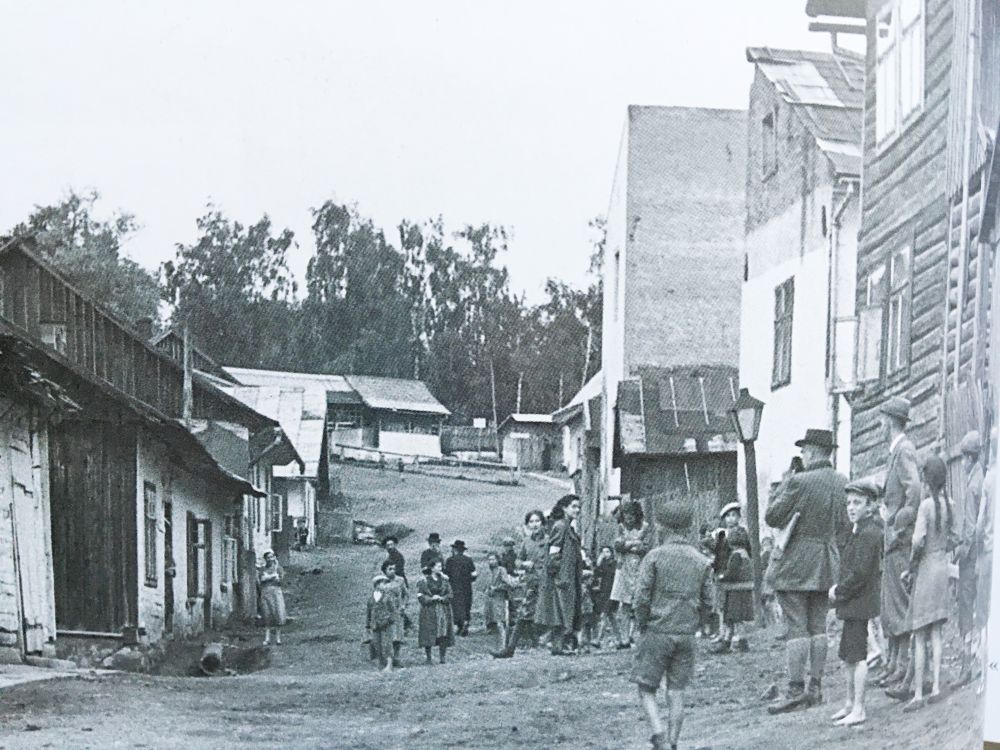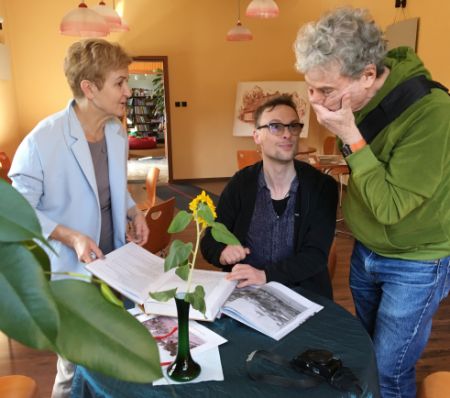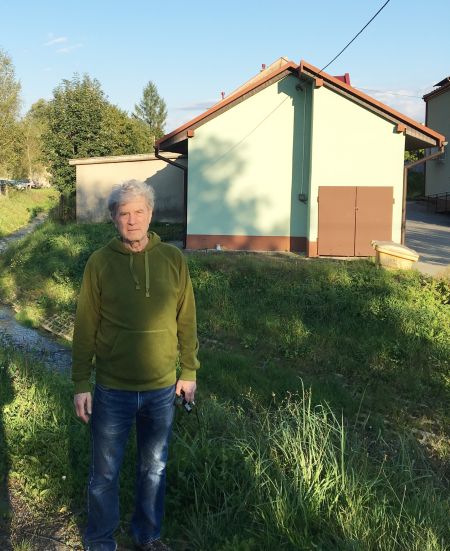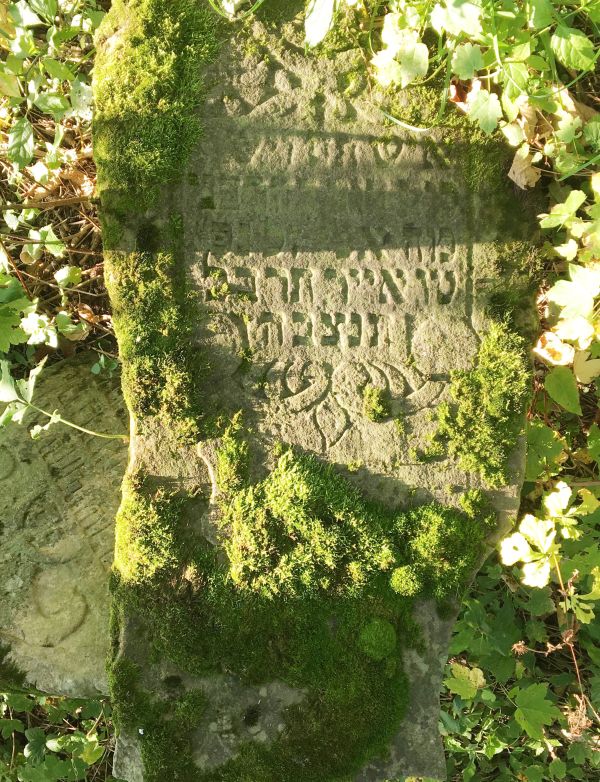

Since I was a young child, I listened attentively to the stories told by my maternal grandparents and great-grandmother about the old country. The memories faded long ago, and since my grandfather was mostly reserved and introverted, only a single word remained etched in my mind—Frystyk, the shtetl where my grandfather, Nathan Fried, and his numerous siblings and step-siblings grew up in the Austrian empire of the late nineteenth and early twentieth centuries. At one point, as I was growing up, my grandmother told me Frystyk was destroyed by the Nazis. Frystyk—the Yiddish word sounded so odd--like a whisper or a curse. I thought of fish sticks or the magical word, mystic.
A large part of my life was defined by the holocaust. It was odd because most of my family left Eastern Europe and Russia before the Nazis invaded,
and I know of no immediate relatives murdered in the concentration camps. My grandparents did not speak of the Nazis or the Polish collaborators,
but on Passover, when we dipped our knives into the wine and tapped each drop of blood-like wine onto our plates, reciting the names of the plagues,
my mother told me that shortly after the war, my grandfather added a eleventh plague--Hitler.

The photograph is of Jewish People wearing armbands
Recently, however, having long ago married a German and traveled throughout Germany and Poland, I discovered that I inherited a kind of vicarious war trauma from my father, who fought in Germany and Austria during the war and choose me as the sole recipient of his grisly war stories. As part of my journey to unburden myself of the brutalities of the holocaust, I took to the internet to see what I could learn about my grandfather’s homeland. And there it was—Frystak, fully alive and well, deep in the countryside of Galicia.
The never-ending journey continued. I took the opportunity of an invitation to a professional conference in Krakow to organize a visit to Frystak. Having some knowledge of German and letting go of my youthful fantasy of fish sticks, I imagined the town was a Yiddish transliteration of Freistadt or Freetown, which made sense as my grandfather’s surname was Fried, meaning free or peace. When I did some research I found a different darkly mythic story. It was about an ancient warlord who ransacked the town, killing all its residents early in the morning, then eating breakfast. And so he named the town Fruhstuck, German for breakfast, which became Frystak in Polish and Frystyk in Yiddish.
My guide, Adrian, was a fellow drama therapist who lived in Australia but grew up in Wroclaw, Poland, and spent summers with his grandparents in Galicia. I sent him an old document written 60 years earlier by my grandfather’s sister, Nettie Fried, who also grew up in Frystyk. She described not only the old house at the bottom of the hill where they lived, but also the living conditions just before the First World War including the Cossack pograms that unsettled all the Jews in the various Polish shtetls. She also described the lineage of the Fried family in Poland and in the diaspora to the US and South America. Adrian contacted several organizations in Frystak for information on the Fried family, sending along Nettie’s document. The correspondence was sent along to a local librarian, Jolanta Zarszynska, who offered to meet us at the library. Adrian was the translator.
In preparing for the visit, I made my third journey to Auschwitz and Birkenau. Since my last visit in 2010, Auschwitz I had become a booming tourist attraction, with shiny megabusses parked in the expanded parking lot, tourists from all over the world snapping photos of signs near a snack stand just outside the camp. The irony of grabbing a ham sandwich before entering the camp did not escape me. Our guide, speaking in an affectless monotone, ran us through the barracks and extermination chambers and cells at a breathless pace. When I questioned him about respecting the spiritual and emotional needs of the visitors, he responded: ‘I have four more tours to do today.’ The grotesqueries of the camps multiplied many fold on that day.
From Auschwitz, we went on to Warsaw, where we visited the restored grave of my friend’s great-grandmother, a levite like me, in the old Jewish cemetery just on the other side of the one remaining wall of the Warsaw ghetto. It was a gloomy day and we entered a tiny windowless office, reeking of cigarette smoke, where a harried Jewish man sitting in front of an ancient computer screen scowled at us for making him look up the placement of another old gravestone. Without speaking he marched us through the twisted underbrush and broken stones, some supported tentatively by rotting tree trunks . As soon as we found the restored site, he vanished into the gnarled surroundings. As we were leaving, I noticed a number of young people with garden tools, cutting back the underbrush. They told me that they answered an internet message to volunteer in clearing out the years of neglect and disrespect of the Jews of Warsaw. A visit to the impressive new Museum of the History of Polish Jews located within the former Warsaw ghetto affirmed the commitment of many Polish business leaders and politicians to honor the Jewish heritage in Poland that spans six centuries, well transcending the six years of the holocaust. The museum felt to me like an attempt to answer the question: What is a Jew? When I left I had more questions than answers and continue to be puzzled by the identity of the historical Jew in Poland. Is Jewishness a race? nationality? religion? culture? Why has the Jew been so maligned throughout history and thus identified as a pariah? Is the idea of a Polish Jew an oxymoron?
As I entered the town of Frystak, the questions continued to resonate. Arriving, I had the same feeling I do when I enter at a sacred space—a disembodied
sense of weightlessness, an awareness of entering rarefied ground. Adrian photographed me standing in front of the town sign, something I have never done
before. But this place never felt real to me, and standing there like millions of tourists do when they first arrive in Venice or Paris or, for that matter,
Auschwitz, situated me in time. I was here now and I had proof. We drove into the small town and the first thing I and most everybody else saw was the
old church, undergoing renovation. It was visible from every corner. Across the street was Kebab City, where several teens hung out. I approached two
adolescent boys and foolishly asked if I could take their picture. They gestured no and blushed a deep red. Retreating to safer ground, we asked for
directions to the library and they gestured just up the road. Jolanta, the librarian, was warm and very gracious. She immediately showed me a book of
photographs depicting the history of Frystak as well as a book listing the names of immigrants from Frystak to New York. The latter had the name Nathan
Fried clearly inscribed, and I learned that my grandfather left Frystak in 1913 at the age of 20.
 The small library was tidy, hushed and bright. A large
straw sculpture, which reminded me of a Christmas crèche, stood prominently in the entranceway. Jolanta told us she built the piece for the local harvest
festival. Several children sat at old computer screens and others played board games in an adjacent room. A red, round beanbag chair was prominent in
the little room that housed the children’s books. Unlike other small town libraries, there were no old people present. A straw basket was proudly displayed
in the window of the larger conference room, where we sat with Jolanta, learning about the history of Frystak. Jolanta and Adrian spoke animatedly for what
felt like a long time, and I was getting restless, knowing our time was limited. I told Adrian I want to especially see the old Jewish ghetto and cemetery,
and the ground, if not the house, where my grandfather grew up. Jolanta had already planned to show me all three. She needed a warm-up and Adrian was
happy to comply.
The small library was tidy, hushed and bright. A large
straw sculpture, which reminded me of a Christmas crèche, stood prominently in the entranceway. Jolanta told us she built the piece for the local harvest
festival. Several children sat at old computer screens and others played board games in an adjacent room. A red, round beanbag chair was prominent in
the little room that housed the children’s books. Unlike other small town libraries, there were no old people present. A straw basket was proudly displayed
in the window of the larger conference room, where we sat with Jolanta, learning about the history of Frystak. Jolanta and Adrian spoke animatedly for what
felt like a long time, and I was getting restless, knowing our time was limited. I told Adrian I want to especially see the old Jewish ghetto and cemetery,
and the ground, if not the house, where my grandfather grew up. Jolanta had already planned to show me all three. She needed a warm-up and Adrian was
happy to comply.
As we walked through the town, my mind wandered to the old Frystyk as described by my grandfather’s sister, Nettie Fried. I was alive in the past and the present simultaneously. Jolanta pointed out the former ghetto where the Nazis herded all the local Jewish citizens. And as we descended a steep residential street, I recalled Nettie’s description of its stratification: the merchants and shopkeepers at the summit, the poorer Jews at the bottom. Many of the old Jewish houses were still intact. Jolanta, herself, lived in an old house that was owned by a Jewish family. At the hill’s nadir was a narrow stream that fed into a larger river. The Fried family lived there. Here is Nellie description:
The house was on one level where three families lived. The middle house had a store, and the end, where we lived, was joined to a stable housing our cow and horse. The back of the house had a large garden where we grew vegetables. The two buildings at the edge of the creek were used for storing hay, straw, and equipment for threshing and cutting straw to feed the animals. We also had geese, chickens, and turkeys. The small children had to find where they laid their eggs. When gathered, my mother sold them.
My grandfather’s house was no longer standing, said Jolanta. But she gestured to the ground where it once stood. When I placed myself on top of that ground,
I had arrived. This is what I had come to discover.
 Not the long vanished past of my ancestors, but the ever-present moment of some internal home. It was
a moment that linked me with the spiritual guidance of my grandfather who now spoke to me in a way he never could when we were in each other’s presence.
And my arrival far transcended my dissociated moments in Auschwitz. I did not come from Auschwitz. I no longer defined my identity as a victim and survivor.
I came from peasants who grew up in a small town with people who, like other people in other small towns in central and eastern Europe, harbored fears and
jealousies and fantasies of Jews. And like Nettie Fried and Nathan Fried and so many of their siblings and cousins, I found my way to a new world to forge
a new identity. As I grow older I am well aware of the mysterious presence of the absent past, which brought me to Frystak to reconvene my dialogue with the
elders.
Not the long vanished past of my ancestors, but the ever-present moment of some internal home. It was
a moment that linked me with the spiritual guidance of my grandfather who now spoke to me in a way he never could when we were in each other’s presence.
And my arrival far transcended my dissociated moments in Auschwitz. I did not come from Auschwitz. I no longer defined my identity as a victim and survivor.
I came from peasants who grew up in a small town with people who, like other people in other small towns in central and eastern Europe, harbored fears and
jealousies and fantasies of Jews. And like Nettie Fried and Nathan Fried and so many of their siblings and cousins, I found my way to a new world to forge
a new identity. As I grow older I am well aware of the mysterious presence of the absent past, which brought me to Frystak to reconvene my dialogue with the
elders.
To do so more directly, I asked Jolanta to bring me to the Jewish cemetery. First, she said, we had to find the old man who has the key. She took us to a
small disordered toyshop. The proprietor, who also sold lotto tickets, was present. After Adrian bought a ‘winning’ ticket, the man gave me the key. It
was frail and rusty. I asked him how many visitors came by the shop for a key. About 10 a year, he replied. The cemetery was in the backyard. The key fit
and we entered. The grounds were in very poor repair, more densely overgrown than the one in Warsaw. It was difficult to find the stones as most were broken,
weather beaten and buried in the earth. We located several, took photos and wandered through the dense brush of decaying memories.
 In the back of my mind,
I hoped to find the stone of Nathan Fried’s father, Israel, who died before the First World War. No luck. As we were leaving, Jolanta told us that the
local Polish government had been in charge of caring for the cemetery but had recently given over the task to the Jewish community.
In the back of my mind,
I hoped to find the stone of Nathan Fried’s father, Israel, who died before the First World War. No luck. As we were leaving, Jolanta told us that the
local Polish government had been in charge of caring for the cemetery but had recently given over the task to the Jewish community.
How large is the Jewish community in Frystak? I asked. There are no Jews in Frystak, she replied.
After a delicious fish lunch at a traditional restaurant outside of town, we said goodbye to Jolanta, offering our deepest thanks for her research and guidance. As she departed, she pointed us in the direction of the second old Jewish cemetery. It was a large circular space in a residential area, a broad field even more overgrown than the first. There was no indication that this was a cemetery, and no sign of any long buried headstones. With no gate and no key, there was no visible way of entry. We stared at the grounds silently, then moved slowly into the street toward our car. On the way, I photographed an old house in the throes of renovation. As I did a car pulled up with a couple inside, late-forties. The woman spoke to me and I made it clear I did not speak Polish and called to Adrian, who as usual was galloping ahead of us. By the time he arrived, the man became very agitated and verbally aggressive. Adrian responded in kind and they exchanged harsh words as we left. Back at the car, Adrian explained it was important for us to experience this moment. The man was incensed that I photographed his house. Adrian was incensed that the man was so aggressive. And I came to realize that many of the settled residents of Frystak, once Frystyk, lived alongside and above the remains of the Jews who once graced this and so many thousands of Poland’s towns, in spite of the pograms, until the Nazis changed the landscape forever.
And so I left this bucolic village with a deep realization that the final solution was hardly final and that life does go on following genocide, and the dead continue to commune with the living, both those who mourn and honor them and those who revile and fear them. In Frystak I discovered my ability to stand in the tangled undergrowth and splendid groundedness of family and history and to stand in a present that continues to surprise and scare me. This is what I came to find. This is the gift that I brought home.
To contact Robert Landy, click here to email Robert Landy
As a surprising and wonderful postscript, when I returned home I corresponded through the Gesher Galicia Discussion Group on JewishGen, with others who
walked the same roads of Frystyk searching for the same presences. In an exchange with three intrepid Polish journeyers, Beth, Meryle and Russ, we
discovered that we had common relatives and a common bond. I shared with them Nellie Fried’s document about Frystyk, which revealed a missing branch in the
family tree. They welcomed me into the family, and it deeply warmed my heart. I shared this story with my grandfather’s only surviving daughter, Helene,
and we reaffirmed our abiding love for one another and our commitment to allowing the past to deeply and brightly inform the present.
Since July2017 you are visitor #
Return to Table of Contents